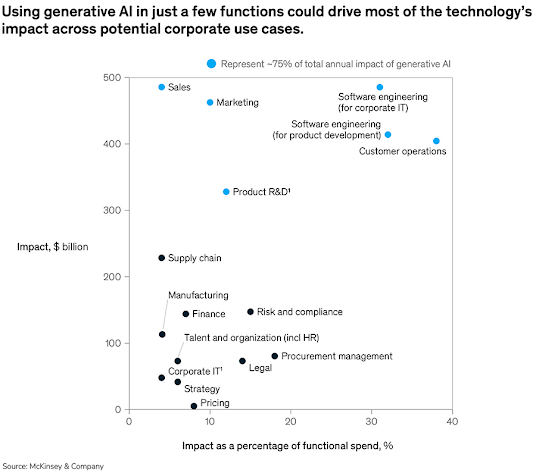Why does growth matter?
But there’s hope. Artificial Intelligence (AI) promises to transform the traditional role of managers and revitalize productivity across industries. By leveraging AI to automate, analyze, and support, UK businesses could overcome management challenges and regain a competitive edge in the global market.
This post explores the link between poor management and low productivity, the transformational role of AI, and what the future might look like for UK managers and business leaders worldwide who struggle to increase productivity and innovation.
The Problem: A History of Management Struggles
From 2008 to today, the UK's output per worker has barely shifted, with the country's productivity growth 36% lower than it would have been had pre-2008 trends continued.
Why has productivity stalled?
- Outdated Practices: Many businesses still rely on manual, inefficient systems that no longer suit the complex demands of modern work.
- Leadership Gaps: Poor investment in management training and leadership development leaves many managers unequipped to lead teams effectively.
- Resistance to Innovation: A failure to adopt emerging technologies like AI, which could improve efficiency, has further slowed progress.
Citi reports a sharp reduction in high-growth UK firms, signaling a troubling lack of ambition and innovation. The UK needs to make bold changes to reverse this trend.
Enter Artificial Intelligence.
The Role of AI in Revitalizing Management
AI isn’t just a tech buzzword; it’s an effective tool capable of transforming businesses from the ground up. While human leaders are (and will remain) essential, AI is a powerful assistant that enhances productivity and decision-making. Here’s how AI could revolutionize management practices in the UK:
1. Automation of Routine Tasks
Managers spend disproportionate time on administrative tasks like scheduling, reporting, and monitoring project progress. AI can streamline these processes**. Tools like intelligent schedulers, automated KPI trackers, presentation aids, and email assistants reduce time spent on operational tasks, allowing managers to focus on strategic priorities.
Imagine a manager freed from repetitive admin work and instead focusing on leading team initiatives or solving customer challenges. Automated tools make this shift possible.
2. Smarter Decision-Making with Data Insights
Statistics show that 63% of managers admit to struggling with data analysis. AI thrives at processing vast volumes of data and generating actionable insights at scale. AI platforms can analyze team performance, market trends, customer preferences, and real-time budget allocations.
For example, AI-driven dashboards powered by tools like Tableau or Power BI generate reports that help identify inefficiencies and opportunities immediately. Managers can confidently make evidence-based decisions to optimize costs, enhance operations, and deliver more impactful results.
3. Employee Development Powered by AI
Employees drive productivity, but many managers lack the tools to nurture their teams effectively. AI systems analyze employee performance metrics to identify skill gaps, recommend tailored training programs, and even evaluate engagement levels.
Platforms like Lattice or Humu provide predictive analytics to managers, helping them understand when employees might disengage and offering solutions to re-engage them proactively. The result? A happier, more motivated, and highly skilled workforce.
4. Enhanced Team Collaboration
Miscommunication and siloed teams* are productivity killers. AI can eliminate these pain points by integrating communication tools that streamline collaboration. AI analyses interpersonal dynamics and identifies team bottlenecks while recommending solutions.
For example, platforms like Microsoft Teams use AI to suggest optimal meeting times across time zones or flag communication breakdowns within teams.
5. AI-Driven Leadership Development
Leadership is crucial to productivity, yet many UK managers lack sufficient training. AI tools go beyond assisting with tasks and actively help managers improve their skills. Platforms like Butterfly.ai or CoachHub provide personalized coaching and real-time feedback on leadership behaviors, enabling managers to learn and grow in their roles.
With AI as a leadership coach, managers can gain unbiased assessments of their strengths and identify areas for improvement, accelerating their ability to lead teams effectively.
Why Human Judgment Can’t Be Replaced
While AI brings substantial benefits, businesses must recognize that it is a supplement to, not a replacement for, human managers. AI can process complex datasets and make recommendations but lacks the creativity, empathy, and moral judgment that human leaders bring.
For example, managing a team through a crisis, building trust, and resolving conflict are areas where human intelligence continues to outshine even the most ingenious algorithms. The key lies in striking a balance, where humans use AI as their sidekick to amplify their strengths, not substitute them.
Transparency and trust are critical ingredients in ensuring AI adoption within organizations. Managers must explain how AI tools are used, establish unbiased algorithms, and demonstrate fairness in data handling to maximize their teams’ confidence in the technology.
Managers of the Future
The introduction of AI will inevitably transform managers' responsibilities, but not in the way many fear. Rather than eliminating managerial roles, AI will allow future managers to focus on higher-level strategic initiatives while delegating routine tasks and data-heavy analysis to machines.
Here’s what the skill set of a future manager might look like:
- Strategic Visionaries: Managers will spend more time focusing on long-term business direction and innovation. Think big-picture strategies rather than daily operational concerns.
- Data-Driven Decision-Makers: With AI tools generating actionable insights, managers must interpret, adapt, and drive outcomes based on this information.
- Collaborators and Culture Champions: Managers will continue prioritizing team cohesion and culture, leveraging AI to enhance collaboration without losing the human touch.
- Continual Learners: AI evolves rapidly, meaning managers must stay updated with advanced tools and techniques to remain effective.
The combination of empathetic leadership and AI-generated efficiency will define what it means to be a great leader in the future. Managers will require different skill sets from today and must adapt to remain successful.
A Brighter Future for UK Productivity
The stagnation of productivity in the UK is not irreversible. AI offers the tools needed to automate inefficiencies, enhance decision-making, and develop talent—turning current management challenges into opportunities for growth. However, success will require more than just implementing technology—it will need managers willing to adapt, learn, and lead purposefully.
To remain competitive in the global economy, the UK must prioritize both AI integration and comprehensive management development. By doing so, businesses can thrive in an increasingly fast-paced world.
Now, the question is no longer whether AI can enhance productivity in management—it’s whether businesses are ready to make that leap forward.
PwC estimates that by 2030, AI could increase global GDP by $15.7 trillion, with increased productivity being the most significant driver.
What are my favorite Marketing AI tools right now?
As a full-stack marketer, I must choose Jasper AI, the perfect AI marketing platform. I also love Piktochart—there is no need for heavy design teams to build my e-books anymore!
*Silos happen because of the culture - culture is created by the leadership team. The psychology of silos in organizations runs deep, is complex, and is hard (sometimes impossible) to reverse. Therefore, though AI can help solve these problems, realistically, it requires more penetrating (human) work deep into the organization. Superficial or tech-only fixes rarely work on such ingrained issues.
**Notion is a good AI Management tool if it is appropriately configured.
Further reading -
For Success with AI, Bring Everyone On Board
























